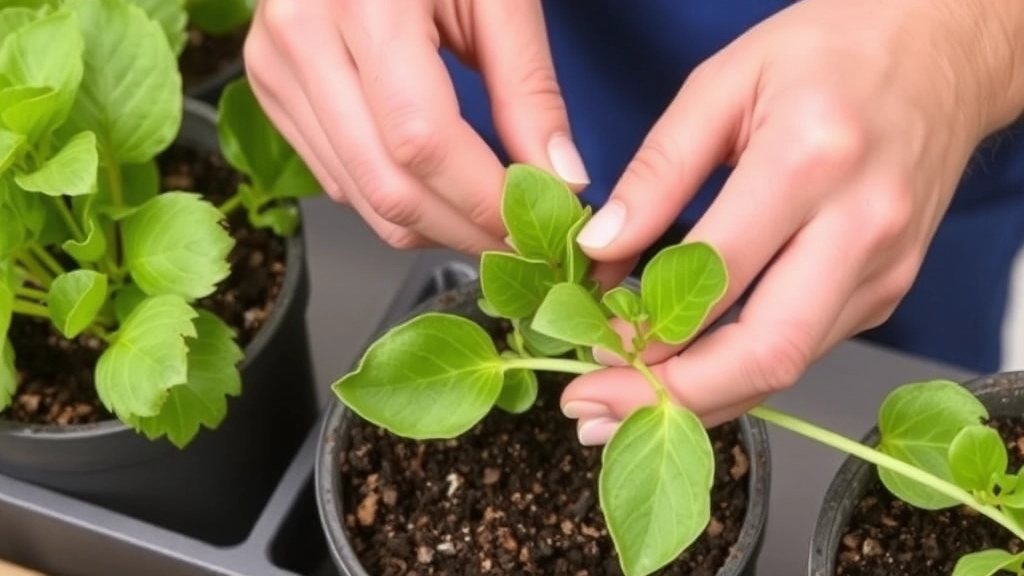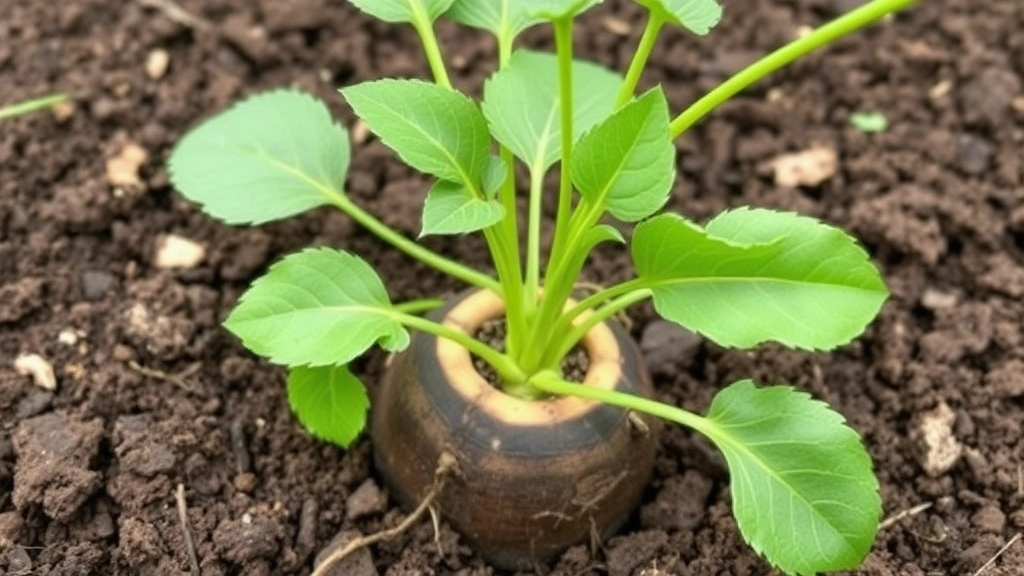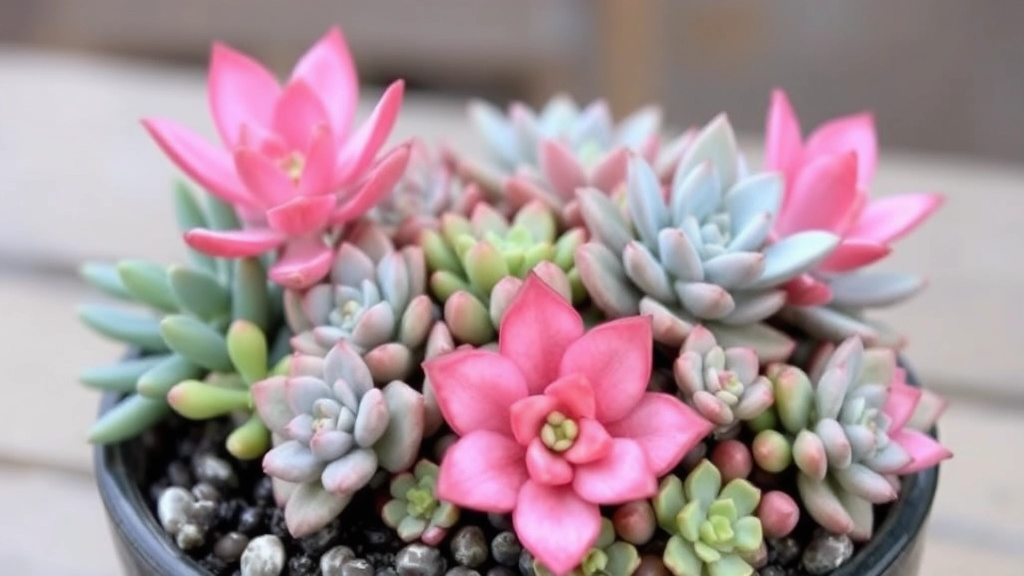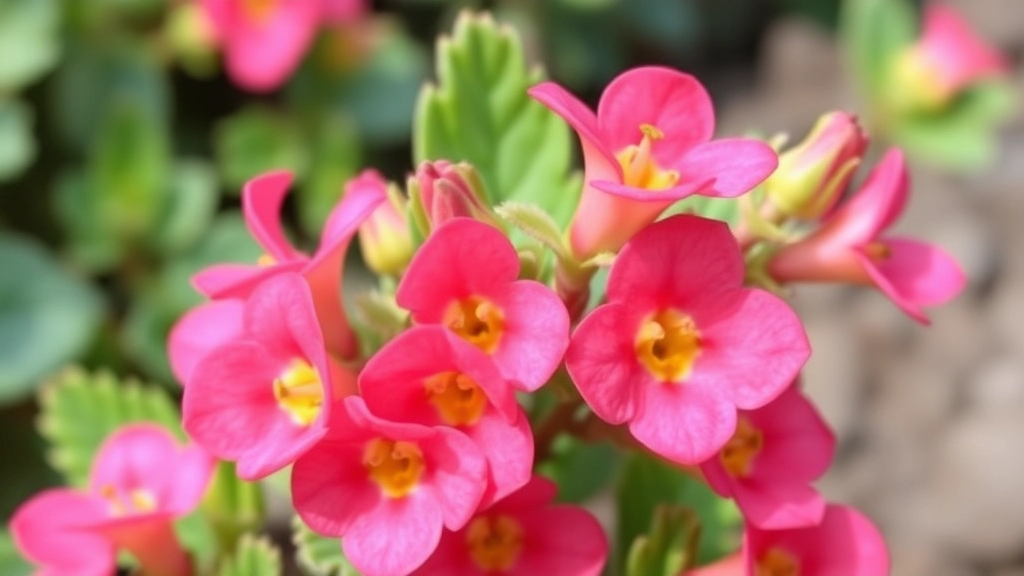Kalanchoe Tomentosa ‘Dorothy Brown’
When it comes to easy-care houseplants, Kalanchoe Tomentosa ‘Dorothy Brown’ is a standout. Also known as the Panda Plant or Chocolate Soldier, this succulent boasts velvety leaves with distinctive chocolate-brown edges. Perfect for beginners, it thrives in indoor environments and requires minimal maintenance, making it a popular choice for plant enthusiasts.
Care Requirements
Understanding the unique features of the ‘Dorothy Brown’ variety is key to its care. This succulent is drought-tolerant, preferring well-draining soil and bright, indirect light.
Propagation
- Leaf cuttings
- Stem cuttings
Whether you’re looking to propagate it through leaf or stem cuttings or simply want to add it to your succulent arrangement, Kalanchoe Tomentosa ‘Dorothy Brown’ is versatile and resilient, making it a delightful addition to any plant collection.
Kalanchoe Tomentosa ‘Dorothy Brown’: Overview
Are you looking for a unique succulent to brighten up your indoor or outdoor space?
Kalanchoe Tomentosa ‘Dorothy Brown’, commonly known as the Panda Plant, is an eye-catching addition to any plant collection.
This charming variety is beloved for its fuzzy, silver-grey leaves adorned with striking brown edges, making it a standout among succulents.
Originating from Madagascar, this plant thrives in various conditions, making it a popular choice for both novice and experienced gardeners alike.
Key Characteristics:
– **Leaf Texture**: Velvety and covered in fine hairs.
– **Growth Habit**: Compact, reaching about 30 cm in height.
– **Flowers**: Produces tubular yellow flowers in the right conditions, though flowering is rare indoors.
For more detailed care instructions, you can check out our [complete guide to Kalanchoe Tomentosa care](https://planthq.org/how-to-care-for-kalanchoe-tomentosa-complete-guide/). If you’re interested in exploring other varieties, our [guide on Kalanchoe Tomentosa varieties](https://planthq.org/kalanchoe-tomentosa-varieties-care-types-and-propagation/) offers valuable insights.
Distinctive Features of the ‘Dorothy Brown’ Variety

So, you’re curious about what makes Kalanchoe Tomentosa ‘Dorothy Brown’ stand out?
This delightful succulent is often called the Panda Plant, and it’s not hard to see why.
Key Features:
- Fuzzy Leaves: One of the most charming aspects of ‘Dorothy Brown’ is its velvety, fuzzy leaves. They’re covered in tiny hairs, giving them a unique texture that feels lovely to the touch.
- Distinct Colouration: The leaves sport a beautiful mix of green and brownish hues. The edges often have a reddish-brown tint, which adds a splash of colour to your plant collection.
- Compact Growth Habit: This variety tends to stay relatively small and compact, making it perfect for windowsills or small spaces.
- Flowering Potential: When happy, ‘Dorothy Brown’ can produce lovely tubular flowers. These blooms are usually a soft yellow or orange, providing a nice contrast against the foliage.
- Resilient Nature: This succulent is forgiving, making it ideal for both beginners and seasoned plant parents.
Feeling inspired by its unique features?
When considering the ideal growing conditions for Kalanchoe Tomentosa, also known as the Panda Plant, it’s essential to create an environment that mimics its native habitat. This succulent thrives when provided with the right balance of light, temperature, and soil type.
### Light Requirements
– **Bright Indirect Light**: Kalanchoe Tomentosa flourishes in bright, indirect sunlight.
– **Avoid Direct Sunlight**: Prolonged exposure to harsh, direct sunlight can scorch its delicate leaves.
### Temperature Preferences
– **Warm Temperatures**: This plant prefers a temperature range of 20°C to 25°C (68°F to 77°F).
– **Avoid Cold Drafts**: Sudden drops in temperature below 10°C (50°F) can be detrimental.
### Soil Type
– **Well-Draining Soil**: A cactus or succulent potting mix is ideal.
– **DIY Mix**: You can create your own by combining standard potting soil with coarse sand or perlite for enhanced drainage.
### Humidity Levels
– **Low Humidity**: Kalanchoe Tomentosa does best in low humidity environments, typical of its native arid conditions.
### Fertilisation
– **Minimal Feeding**: During the growing season (spring and summer), a diluted succulent fertilizer can be applied once a month.
For more detailed care tips, you can refer to the [complete guide to Kalanchoe Tomentosa care](https://planthq.org/how-to-care-for-kalanchoe-tomentosa-complete-guide/). Additionally, if you’re interested in exploring the different varieties of this beautiful succulent, check out the [types of Kalanchoe Tomentosa](https://planthq.org/types-of-kalanchoe-tomentosa-varieties-and-care-tips/).
Indoor vs Outdoor Care: What to Consider

When deciding whether to keep your Kalanchoe Tomentosa ‘Dorothy Brown’ indoors or outdoors, it’s essential to weigh the unique needs of this charming succulent against your living environment.
Indoor Care Considerations
- Light Requirements:
- Place your plant near a bright window, ideally one that receives indirect sunlight.
- If the light is too harsh, consider using sheer curtains to diffuse it.
- Humidity Levels:
- Indoor environments tend to be drier, especially in winter.
- To maintain optimal humidity, consider using a pebble tray with water beneath the pot or a small humidifier.
- Temperature:
- Kalanchoe thrives in temperatures between 18°C to 24°C.
- Avoid placing it near drafts or heating vents.
- Watering:
- Check the soil moisture regularly; indoor plants may need less frequent watering.
- Allow the soil to dry out completely between waterings.
Outdoor Care Considerations
- Sun Exposure:
- Outdoors, this plant enjoys full sun but can benefit from some afternoon shade in hotter climates.
- Soil Type:
- Use well-draining soil, ideally a cactus mix or a combination of potting soil and sand.
- Temperature:
- Ensure outdoor temperatures remain above 10°C, as Kalanchoe is not frost-tolerant.
- Watering:
- Water less frequently during the cooler months, as outdoor conditions can lead to faster evaporation.
Making the Decision
Ultimately, your choice between indoor and outdoor care will depend on your local climate and your home’s conditions.
- Assess Your Environment:
- If you have a sunny window and stable indoor temperatures, indoor care might be ideal.
- Conversely, if you live in a warm climate with ample sunlight, outdoor care could be beneficial.
Watering and Drainage Needs of the Panda Plant
When it comes to caring for Kalanchoe Tomentosa, or the Panda Plant, one of the most common concerns is how to properly manage watering and drainage. Overwatering is a frequent mistake that can lead to serious issues, so understanding the needs of this unique succulent is essential.
Watering Guidelines
- Frequency: Water your Panda Plant every 2-3 weeks during the growing season (spring and summer). In the winter, reduce watering to once a month.
- Soil Moisture: Always check the soil moisture before watering. Stick your finger about an inch into the soil; if it feels dry, it’s time to water.
- Watering Technique: Water thoroughly until you see it draining from the bottom of the pot. This ensures that the roots receive adequate moisture.
Drainage Essentials
- Pot Choice: Use pots with drainage holes to prevent water from accumulating at the bottom. Terracotta pots are ideal as they absorb excess moisture.
- Soil Type: Opt for well-draining soil, such as a cactus or succulent mix. You can also create your own by mixing regular potting soil with sand or perlite.
- Avoid Saucers: If you use a saucer under the pot, be sure to empty it after watering. Standing water can lead to root rot.
Understanding these watering and drainage needs will help your Kalanchoe Tomentosa thrive and prevent common issues related to overwatering. For more detailed instructions, check out our complete guide on caring for Kalanchoe Tomentosa. Additionally, you can explore various Kalanchoe Tomentosa varieties and propagation techniques to expand your succulent collection.
Propagation Techniques: Leaf and Stem Cuttings

So, you’re thinking about expanding your collection of Kalanchoe Tomentosa ‘Dorothy Brown’? Great choice! Propagation is not only fun but also a fantastic way to share your love for this unique plant with friends.
Leaf Cuttings
- Choose Healthy Leaves:
- Look for plump, healthy leaves.
- Avoid any that show signs of disease or damage.
- Cut the Leaf:
- Use a clean, sharp knife or scissors.
- Cut the leaf from the stem, leaving a bit of the base attached.
- Let It Callous:
- Place the leaf in a dry spot for a few days.
- This helps to prevent rot when you plant it.
- Plant the Leaf:
- Once calloused, place the leaf on well-draining soil.
- You can lightly press it down, but don’t bury it.
- Water Sparingly:
- Mist the soil lightly, but avoid soaking it.
- Keep it in bright, indirect sunlight.
Stem Cuttings
- Select a Healthy Stem:
- Look for a stem with several leaves.
- Ensure it’s robust and free from pests.
- Make the Cut:
- Cut a few inches of the stem just below a leaf node.
- Again, use clean tools to avoid contamination.
- Let It Callous:
- Just like with leaf cuttings, let the cut end dry for a few days.
- Plant the Stem:
- Insert the calloused end into well-draining soil.
- Water lightly to settle the soil around it.
- Provide Care:
- Keep your cutting in a warm, bright spot.
- Water only when the top inch of soil is dry.
Tips for Success
- Humidity:
- If you’re in a dry area, consider using a plastic bag to create a mini greenhouse effect.
- Patience is Key:
- It may take a few weeks for roots to form, so don’t rush it!
As we delve deeper into the care of Kalanchoe Tomentosa ‘Dorothy Brown’, it’s essential to address the common pests that can affect this charming succulent. While these plants are generally hardy, they aren’t immune to infestations.
### Common Pests to Watch For:
– **Mealybugs:**
– **Appearance:** Small, white, cotton-like clusters on leaves.
– **Treatment:** Use a cotton swab dipped in rubbing alcohol to wipe them away. For severe infestations, consider insecticidal soap.
– **Spider Mites:**
– **Appearance:** Tiny, red or brown specks, often accompanied by webbing.
– **Treatment:** Increase humidity around the plant and spray with water. Neem oil can also be effective.
– **Aphids:**
– **Appearance:** Small, green or black insects on new growth.
– **Treatment:** A strong spray of water can dislodge them. Insecticidal soap is another option.
– **Scale Insects:**
– **Appearance:** Hard, shell-like bumps on stems and leaves.
– **Treatment:** Remove them manually with a soft brush and apply neem oil to prevent further infestations.
### Prevention Tips:
– Regularly inspect your plants for signs of pests.
– Keep the surrounding area clean and free from debris.
– Ensure good air circulation around your plants.
For more detailed care instructions, you can refer to our [complete guide to Kalanchoe Tomentosa care](https://planthq.org/how-to-care-for-kalanchoe-tomentosa-a-complete-guide/) and learn about [different varieties of Kalanchoe Tomentosa](https://planthq.org/kalanchoe-tomentosa-varieties-care-types-and-propagation/).
Preventing Root Rot and Other Common Diseases

So, you’ve got your Kalanchoe Tomentosa ‘Dorothy Brown’ thriving, but what happens when things go south? Root rot can sneak up on you, and trust me, it’s a gardener’s nightmare.
What is Root Rot?
Root rot is a disease caused by overwatering and poor drainage. Your plant’s roots sit in soggy soil, leading to decay. This can be a death sentence for your beloved Panda Plant.
Signs of Root Rot:
- Yellowing leaves
- Wilting despite moist soil
- A foul smell from the soil
How to Prevent Root Rot:
- Well-Draining Soil: Use a cactus mix or add perlite to regular potting soil for better drainage.
- Proper Pot Choice: Choose pots with drainage holes. This allows excess water to escape.
- Watering Wisely:
- Water only when the top inch of soil feels dry.
- In winter, reduce watering frequency.
- Avoid Watering Leaves: Water at the base, not on the leaves. This keeps moisture away from the crown.
- Air Circulation: Ensure your plant is in a spot with good airflow. This helps the soil dry out faster.
Other Common Diseases:
- Fungal Infections: These can appear as spots on leaves. Treat with a fungicide or remove affected leaves.
- Powdery Mildew: A white, powdery substance on leaves indicates this issue. Increase airflow and reduce humidity.
By keeping an eye out for these signs and following the tips above, you can keep your Kalanchoe Tomentosa healthy and happy.
Light and Temperature Requirements for Healthy Growth
When it comes to nurturing Kalanchoe Tomentosa ‘Dorothy Brown’, understanding its light and temperature needs is essential. Many plant enthusiasts often wonder: How much light does my Panda Plant need? What temperatures are ideal for its growth?
Light Requirements
Kalanchoe Tomentosa thrives in bright, indirect light. Here are some key points to consider:
- Direct Sunlight: While it can tolerate some direct sunlight, too much can scorch its leaves.
- Ideal Location: A south or west-facing window is perfect for providing the right amount of light.
- Signs of Insufficient Light: If the leaves start to stretch or lose their vibrant colour, it’s a sign your plant needs more light.
Temperature Preferences
This succulent prefers a warm environment, typically between 18°C to 24°C (65°F to 75°F). Here’s what to keep in mind:
- Avoid Cold Drafts: Protect your plant from cold winds or sudden temperature drops, as it can cause stress.
- Winter Care: During colder months, ensure the temperature doesn’t drop below 10°C (50°F) to prevent damage.
For more detailed guidance on maintaining your plant’s health, check out our complete guide on caring for Kalanchoe Tomentosa. Additionally, if you’re interested in exploring different varieties, our article on Kalanchoe Tomentosa varieties and care tips offers valuable insights.
How to Use Kalanchoe Tomentosa in Succulent Arrangements

So, you’ve got your Kalanchoe Tomentosa ‘Dorothy Brown’ and you’re wondering how to showcase this beauty in a succulent arrangement? You’re not alone! Many of us want to create stunning displays that catch the eye and bring some life to our spaces.
Why Kalanchoe Tomentosa?
This plant, often called the Panda Plant, is a fantastic choice due to its unique fuzzy leaves and striking appearance. Here’s how to make it shine in your arrangements:
1. Choose the Right Container
- Drainage is Key: Pick a pot with drainage holes to prevent waterlogging.
- Size Matters: Ensure it’s not too big; a snug fit helps the roots thrive.
2. Mix and Match with Other Succulents
- Contrast Textures: Pair it with smoother-leaved succulents for a visual treat.
- Colour Coordination: Use plants with complementary colours to enhance the overall aesthetic.
3. Layering for Depth
- Tall Plants First: Start with taller succulents in the back.
- Fill in with Medium and Low Plants: This creates a layered look that draws the eye.
4. Consider the Light Needs
- Group Wisely: Keep your Kalanchoe with other succulents that have similar light requirements. It loves bright, indirect light!
5. Add Decorative Elements
- Stones and Sand: Use decorative stones or sand on top of the soil for a polished look.
- Fun Accents: Tiny figurines or driftwood can add a personal touch.
6. Maintenance Tips
- Rotate for Even Growth: Turn your arrangement occasionally to ensure all sides get sunlight.
- Dust Off: Wipe leaves occasionally to keep them looking fresh.
Repotting Guide for Mature Plants
Repotting your Kalanchoe Tomentosa ‘Dorothy Brown’ is essential for maintaining its health and promoting growth. You might be wondering when and how to repot this beautiful succulent effectively.
Pet Safety: Is Kalanchoe Tomentosa Toxic to Animals?
Have you ever wondered if your cute little Panda Plant is safe for your furry friends?
Kalanchoe Tomentosa, or the Panda Plant, is a lovely succulent that many of us adore. But, as pet owners, we have to be cautious about what plants we bring into our homes.
So, is Kalanchoe Tomentosa toxic to animals?
The Lowdown on Toxicity
- Mildly Toxic: Kalanchoe Tomentosa is considered mildly toxic to pets, particularly cats and dogs.
- Symptoms to Watch For: If your pet nibbles on this plant, they might experience:
- Vomiting
- Diarrhoea
- Lethargy
- Drooling
What to Do If Your Pet Ingests It
If you suspect your pet has munched on your Panda Plant, don’t panic! Here’s what you can do:
- Monitor Them: Keep an eye on any unusual behaviour.
- Contact Your Vet: If symptoms appear, it’s best to consult a vet for advice.
Safe Plant Placement
To keep your pets safe, consider these tips:
- High Shelves: Place your Kalanchoe Tomentosa out of reach.
- Pet-Free Zones: Designate areas where your pets aren’t allowed to roam.
For more tips on ensuring the well-being of your plants and pets, check out our complete guide on Kalanchoe Tomentosa care.
Frequently Asked Questions about Kalanchoe Tomentosa ‘Dorothy Brown’
What makes Kalanchoe Tomentosa ‘Dorothy Brown’ unique?
Kalanchoe Tomentosa ‘Dorothy Brown’ is known for its fuzzy, velvety leaves that have a unique texture. The leaves feature a mix of green and brownish hues with reddish-brown edges, making it a visually appealing plant. Additionally, it has a compact growth habit and can produce tubular flowers in soft yellow or orange.
Is Kalanchoe Tomentosa ‘Dorothy Brown’ suitable for indoor or outdoor care?
This succulent can thrive both indoors and outdoors. Indoors, it needs bright, indirect sunlight, moderate humidity, and temperatures between 18°C to 24°C. Outdoors, it enjoys full sun with some afternoon shade in hotter climates and well-draining soil. Ensure temperatures remain above 10°C as it is not frost-tolerant.
How do I propagate Kalanchoe Tomentosa ‘Dorothy Brown’?
You can propagate this plant using either leaf or stem cuttings. For leaf cuttings, choose healthy leaves, let them callous for a few days, and then plant them in well-draining soil. For stem cuttings, select a healthy stem, let it callous, and then plant it. Water sparingly and provide bright, indirect sunlight for both methods.
What are the signs and prevention methods for root rot?
Signs of root rot include yellowing leaves, wilting despite moist soil, and a foul smell from the soil. To prevent root rot, use well-draining soil, choose pots with drainage holes, water wisely, and ensure good air circulation. Avoid watering the leaves and reduce watering frequency in winter.
Can Kalanchoe Tomentosa ‘Dorothy Brown’ be used in succulent arrangements?
Yes, it is an excellent choice for succulent arrangements. Choose a container with drainage holes, mix and match with other succulents for contrasting textures and colors, and layer plants for depth. Ensure all plants in the arrangement have similar light requirements and add decorative elements like stones or small figurines for a polished look.
How often should I water Kalanchoe Tomentosa ‘Dorothy Brown’?
Water the plant only when the top inch of soil feels dry. Overwatering can lead to root rot, so it’s crucial to let the soil dry out completely between waterings. During the winter months, reduce the watering frequency.
What are common diseases that affect Kalanchoe Tomentosa ‘Dorothy Brown’?
Besides root rot, common diseases include fungal infections and powdery mildew. Fungal infections can be treated with a fungicide or by removing affected leaves. Powdery mildew, identified by a white, powdery substance on leaves, can be managed by increasing airflow and reducing humidity.
What are the light requirements for Kalanchoe Tomentosa ‘Dorothy Brown’?
This succulent thrives in bright, indirect sunlight. If kept indoors, place it near a bright window. If the sunlight is too harsh, use sheer curtains to diffuse it. Outdoors, it enjoys full sun but can benefit from some afternoon shade in hotter climates.
How do I maintain a healthy Kalanchoe Tomentosa ‘Dorothy Brown’?
Ensure it receives the right amount of light, water only when the soil is dry, and use well-draining soil. Rotate the plant occasionally for even growth and wipe the leaves to keep them dust-free. Keep it in a spot with good air circulation to prevent diseases.
References
-
How to Grow Kalanchoe Tomentosa Indoors – The Spruce
-
Kalanchoe Tomentosa ‘Panda Plant’ – World of Succulents
-
Kalanchoe Tomentosa Care Guide – Succulent City
